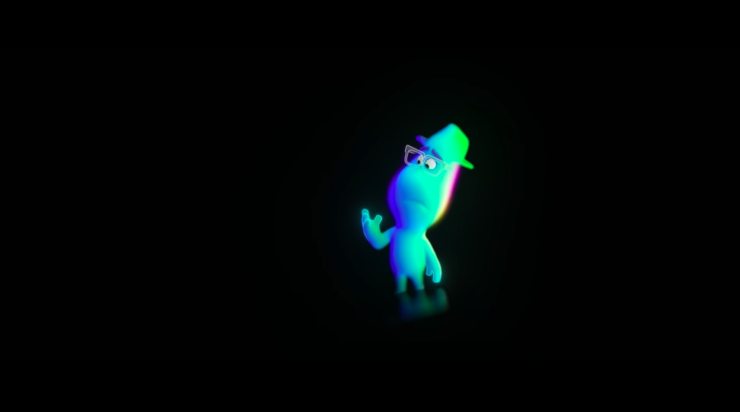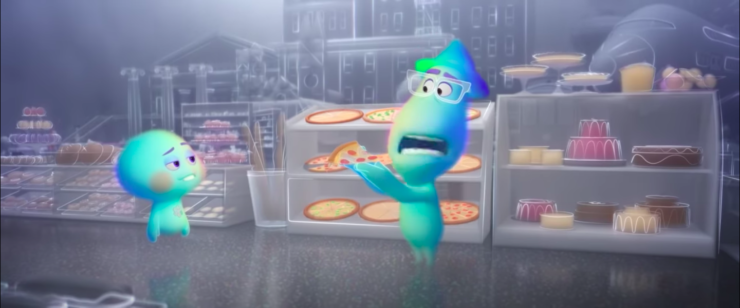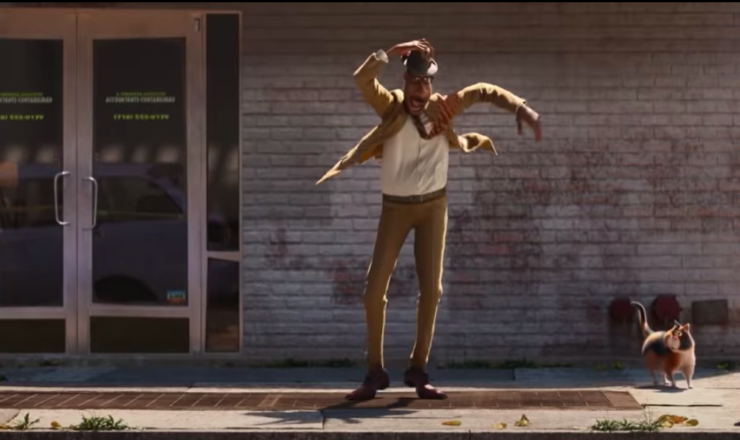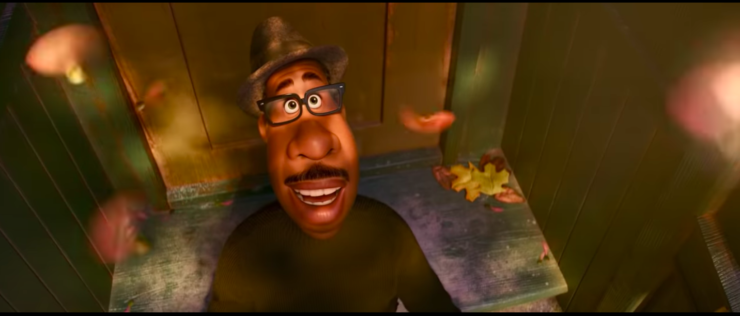The opening of Pixar’s Soul serves as a great metaphor for the movie as a whole.
In the first scene, we’re introduced to a black musician named Joe Gardener, voiced by Jamie Foxx. As he teaches a class of young students, we discover he has a deep passion for jazz. Joe beautifully demonstrates his talents in a scene packed with stunning visuals and excellent sound design. His students, on the other hand, are less sure of themselves and sometimes play off-key. Although they want to handle their instruments better, they don’t quite have the hang of it yet. Ultimately the scene represents what Soul is—a movie that has plenty of passion and beauty, but misses a few notes along the way.
[Some spoilers for Soul]
After Joe gets an offer to teach full time that he isn’t exactly enthusiastic about, he’s given the opportunity to play piano with a well-known jazz musician named Dorothea Williams. While playing, he enters “The Zone” a plane of existence that your soul travels to when you’re doing something you truly love. We see Joe’s hands playing in exquisite detail while reflected in his shiny piano. His melodic playing pulls us in. And at the center of the cool blue visuals is Joe, completely lost in the music. If the rest of “Soul” played out like this meticulously crafted scene, it would’ve become an instant masterpiece. However, there’s a big curveball thrown the audience’s way.
Shortly after Joe’s big audition, he’s so consumed with excitement that he walks right into an open manhole. This accident separates Joe’s soul from his body, leaves him stranded in another world, and most noticeably… turns him into a tiny blue creature. From this point on, he spends the film desperately trying to get back to his body in time to perform a show with Dorothea Williams.

I’ve written before about how disappointing it is to see BIPOC protagonists transformed into animals or creatures when the movie is supposed to revolve around their lives. Unfortunately, this trend is just as disappointing here. Joe is transformed into a small blue soul creature nine minutes and 18 seconds into the film. Seeing Pixar’s first black protagonist forced into a new form before ten minutes had gone by was really disappointing. Although the idea of him being trapped in a new and mysterious world was exciting, I wondered if it was really necessary to overhaul his entire appearance to make that happen.
But as Joe (and the audience) adjusts to his new circumstances, he falls into the “Great Before”, a world where new souls are prepared for life on earth. His interactions with the new souls and instructors are absolutely hilarious. From baby creatures repeating the word “hell” on a constant loop to the casual way instructors talk about life and death, there’s a lot to love in this scene. Things get better when Joe is mistaken for a soul mentor and paired with a soul named 22 (Tina Fey). He’s supposed to help her find a spark, a passion that she’ll want to pursue on earth. If a “spark” isn’t added to the badge she wears, 22 can’t move on. But since she has no desire to live life on earth, Joe offers to help her find a “spark” in exchange for taking the badge off her hands.

Their compromise is a clever way to move the plot forward. And as we learn more about 22, we get a series of great cutaway gags where she drives soul mentors like Mother Theresa and Muhammad Ali to the brink of insanity. But just as we’re getting used to the fantastical rules of the soul world and Fey’s hilarious performance, we’re thrown another major curveball—Joe opens a portal back to his body. When he sees himself in a hospital accompanied by a support cat, he gets so excited that he accidentally takes 22 through the portal too. While she ends up inside his body, he lands inside the body of a cat.
Once again, I found myself confused by the choice to place Joe inside a second non-human being. Although his body technically stays onscreen while 22 is piloting it, he still doesn’t get the opportunity to interact with other people as a black man. And furthermore, since no one can understand Joe while he’s in his cat form, 22 has to translate all of his words for him so he can be heard. Not only is he denied his true identity, but he has to watch as someone else takes agency of his body and speaks on his behalf. I found this aspect way too similar to the body-snatching plot of Get Out. As much as I love that horror movie, I don’t really want a Pixar film to remind me of Jordan Peele’s terrifying film.

While the story struggled to connect us with Joe, 22 came into focus. Although she once hated the prospect of living on earth, she takes delight in every little thing. While in Joe’s body 22 gleefully eats pizza, is fascinated by other people’s stories, and naturally angers someone on the subway. Every experience she has brings her closer to the realization that she doesn’t really want to give up her shot at life. When she becomes so enamored with living that she tries to steal Joe’s body permanently, the two are both dragged back to the soul world by the movie’s mostly absent main antagonist… an accountant named Terry (Rachel House).
After the heroic duo returns to the soul world, a soul instructor tells 22 she found her spark. But she’s nervous about starting life because she’s unsure what her spark is. 22 is then informed, that her spark, the passion that is key to her living life, has nothing to with her ultimate purpose. The soul instructor’s simple statement makes Joe question if his music dreams are the same as his purpose in life. And as far as a moral in a kid’s movie goes, I think it’s incredibly important to teach young audiences that they don’t necessarily have to stay on one path just because they have a certain talent or skill.
Shortly after learning this lesson, 22 gives her badge to Joe. This allows him to return to his body one hour, twelve minutes, and 46 seconds after he left it (in movie time). Now armed with the badge, and by extension, the life he borrowed from 22, he has to decide if he’s going to let her miss her chance to live. And after getting his chance to perform with Dorothea Williams, Joe travels to the “Zone” in the hopes he can give 22 something he’s had years to experience.
Seeing him return back to this plane of existence reminded me exactly what I liked and disliked about Soul. He ascends to the soul world again while being carried by beautiful music and supported by breathtaking visuals. But when Joe arrives, he once again loses his identity in favor of him becoming a blue creature.
If the movie didn’t spend so much time moving Joe from one body to another, it could’ve spent more time exploring the beautifully rendered worlds, fleshing out the villain, or given us more of 22’s brilliant cutaway gags. But most importantly, taking transformations out of this world would’ve given us more time to see Pixar’s first black protagonist struggle with deep themes about the meaning of life while he was actually black.
On the surface, this movie is another gorgeous Pixar picture with important lessons to tell. But it’s hard to ignore that its main plot can’t work unless a black man is left stranded outside his body and robbed of his identity. His drastic transformations kept creating distance between us and his true self. This left the impression that this beautiful looking Pixar film wasn’t fully connected to its main character’s…well, soul.
Soul is now available to stream on Disney+
Andrew Tejada is an NYC native so there’s a 90 percent chance this was written on the subway. When he’s not writing or consuming movies/tv, he’s pitching his Static Shock screenplay to anyone who’ll listen. More of Andrew’s projects and words can be found on Facebook at “Arete Writes Things.”










